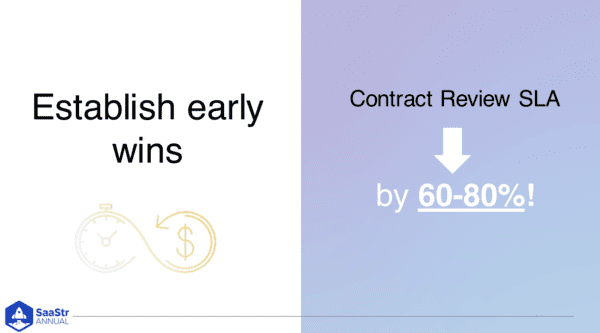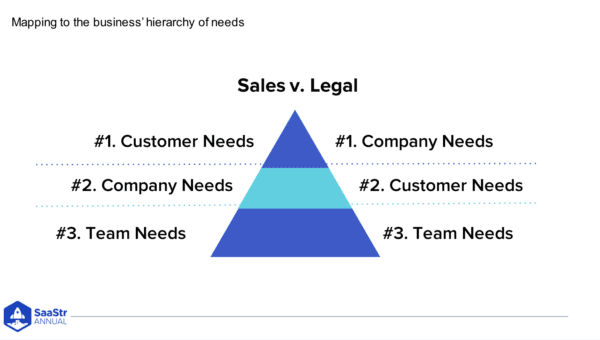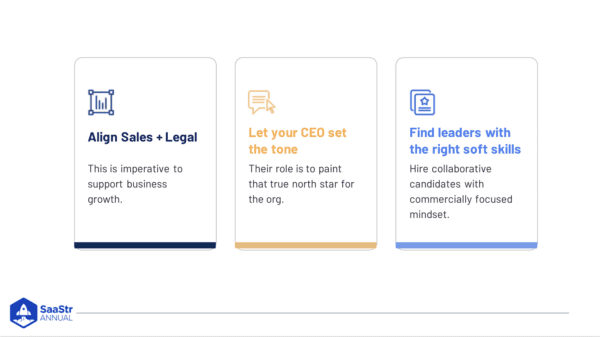For many organizations, friction can arise between the GTM engine and the legal team. And it often comes down to a misalignment in goals. A revenue leader’s responsibility is to drive revenue and grow the company. Their mindset can devolve into thinking they would have an easier time achieving this goal if the legal team stopped interfering. On the other hand, the legal team may feel that the sales team is taking risks that put the company in jeopardy.
Even though Legal and Sales can have different interests, creating a positive working relationship is possible. In an enlightening SaaStr Annual session, G2 General Counsel Eunice Buhler and VP of Enterprise Sales Colin Danaher share how they have found ways to forge a collaborative, respectful, and productive relationship between the revenue and legal teams.
Respect, Communication, and a “Yes” Mindset
A healthy legal and sales relationship comes with many benefits, but most importantly, it helps move the company forward. Danaher says, “Sales, particularly enterprise sales, but all sales and legal have worked together closely [at G2]. We think it’s in the best interests of our customers.” At G2, they have found that a close relationship between sales and legal has moved processes along more quickly. A big part of this success is based on collaboration.
91% of in-house lawyers deliver value through “improved cross-business collaboration. Buhler explains that “Attorneys, and really all business professionals, can deliver much higher value when they’re able to work collaboratively with other business units.”

At G2, the legal team has found a few ways to achieve this successfully:
- Communication: Buhler says that at G2, “Legal is communicating with the revenue org all the time.” Buhler has regular meetings to check in with the CRO, plus additional calls, messages, and meetings in between. She also schedules 1-on-1 meetings with each segment leader for every business unit on a monthly basis. Bulher believes availability is crucial for solid communication: “My entire legal team has made a point to be extremely available to the sales organization because we understand that our goal is to win more customers over together.”
- Respect: It has been easy for the G2 legal team to make themselves available to the sales org because they are respectful. They ensure the respect goes both ways: the legal team emphasizes to the revenue org that they are valued clients and will get help when needed. Danaher agrees with this concept of availability to help make the re
lationship stronger: “Accessibility has probably been one of the underpinnings of the relationship that [Eunice and the legal team] and I have built.” - Mindset: Additionally, having the right lawyers on your team is important. Buhler has an M&A background, so her attitude has always been to avoid slowing a deal down and keep things moving. The attorneys need to think about how to get a “yes” for their clients. If they make a habit of this, it is more likely that respect and patience will hold up in the few instances when Legal has to say no.
The CEO’s Role
If you are a founder thinking about scaling, consider your legal and sales teams and how you can facilitate alignment between them. Find a common North Star goal that both legal and sales can work on together.
While there are times when teams are working in silos, they are all aligned in accomplishing the same goal. As a founder, you are the one who must define the objective. You should be responsible for uniting all disparate business units directionally to the same outcome.
An attorney should understand from the CEO where to draw the line from a risk perspective and understand the priorities when it comes to long-term planning. That means they can offer the most precise counseling.
A good starting exercise is to map each team’s hierarchy of needs:
Mapping to the Business’ Hierarchy of Needs:

It helps to map out the hierarchy of needs to understand the other person’s perspective. To better align, they put themselves in the other person’s shoes. This has helped them collaborate better. They are both clear and aware of each other’s needs consistently, and they model this for their respective teams to promote this culture.
Three Steps to Align Sales & Legal
You can take three steps to create harmony between your legal and sales teams.
- Partner on Customer Negotiations: Discuss the other’s needs, really meet in the middle on your perspectives. Remember the hierarchy of needs!
- Balance Long-Term Risk with Short-Term Gain: Every business arrangement or contract balances risk and reward, both for the present and future. So, it’s essential to discuss legal and business concerns and ultimately decide what’s best for the company.
- Embrace a Commercially Focused Business Mindset: Revenue and Legal both problem-solve as a profession. Solutions should be the goal; simply understanding the risk-reward balance can help guide the outcome.1Password raised capital after running bootstrapped for a decade because they felt like they were leaving money on the table by not having a marketing and finance team. They eventually decided to approach investors in the process of raising funds.

Key Takeaways
- Align Sales & Legal: This is imperative to support business growth.
- Let Your CEO Set the Tone: They paint that true north star for the org.
- Find Leaders With the Right Soft Skills: Hire collaborative candidates with a commercially focused mindset.

